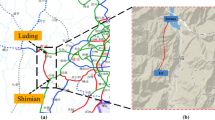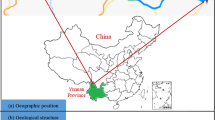Abstract
In order to explore the directional support method of jointed rock mass and ensure the stable operation of roadway, the support effect of jointed rock mass was analyzed by numerical simulation and on-site monitoring. The results showed that directional support could effectively reduce the deformation and ensured the stability of surrounding rock. In the process of directional reinforcement support construction, the plane formed by multiple bolts was guaranteed to be perpendicular to the structural plane, and the bolt hole extended along the normal plane of roadway, the control effect of this support mode was the best. The stress change law of surrounding rock of roadway was monitored by using borehole force meter. The results showed that the stress released occurs in surrounding rock of roadway after excavation, and the cumulative stress change value did not increase 5 to 7 days after excavation. The jointed rock mass remained in a stable state under the action of directional reinforcement support. The directional reinforcement of roadway surrounding rock had a good control effect on roadway stability.
















Similar content being viewed by others
References
Erdogan F, Sih GC (1963) On the crack extension in plates under plane loading and transverse shear. J Basic Eng Trans ASME 85:519–527
Feng G, Zhang J, Jiang Q et al (2021) Synergistic observation and mechanism analysis of time-dependent fracture process of columnar jointed rockmass under strong unloading during excavation. Chin J Rock Mech Eng 40(2):3041–3051 (in Chinese)
Guo Q, Wu X, Cai M et al (2019a) Test sutdy on crack initiation mechanism of pre-existing cracked granite. J China Coal Soc 44(S2):476–483
Guo Q, Wu X, Cai M et al (2019b) Experiment on the strength characteristics and failure modes of granite with pre-existing cracks. Chin J Eng 41(1):43–52
Jiang Y, Hu X (2005) The fracture criterion of the maximum size of plastic zone of mixed mode crack growth. J Sichuan Univ 37(4):11–14 (in Chinese)
Lin B (1985) The mixed mode brittle fracture criteria in sliding mode fracture. Appl Math Mech 6(11):977–983 (in Chinese)
Ren Y (2016) Study on the deformation and stability of the shaoguo tunnel in jointed rock mass. Hebei University of Technology, Tianjin
Sih GC (1974) Strain energy density factor applied to mixed mode crack problems. Int J FractMech 10(3):305–321
Sun J, Wang F, Li Z et al (2022) A new hybrid copula-based nonparametric Bayesian model for risk assessments of water inrush. Qual Reliabil Eng Int 2022(1):1–20
Tan Y, Jiang F, Fan W et al (1999) Simulation of bolting effect on the stability of jointed rockmass by dispersive element method. J Eng Geol 7(4):361–365
Wu X (2019) Directional failure and control of surrounding rock with Non-through cross-type jointed for tunnels. University of Science and Technology, Beijing
Wu X, Wang F, Xi X et al (2020) Experimental investigation on the strength characteristics and fracture mechanism of rock with orthogonally crossed cracks. J China Coal Soc 45(07):2681–2690
Wu X, Guo Y, Sun J et al (2021a) Energy Evolution of Orthogonal Cracked Rock under Uniaxial Loading. Chin J Undergr Space Eng 17(1):114–119 (in Chinese)
Wu X, Zhang L, Sun J et al (2021b) Deformation and energy evolution analysis of granite with cross-cracks under uniaxial compression. J Beijing Jiaotong Univ 45(3):77–83 (in Chinese)
Zhang B, Li SC, Yang XY et al (2014) Bolting effect and failure modes of jointed rock masses with cross-cracks. Chin J Rock Mech Eng 33(5):996
Zhang S, Wang C, Wang G et al (2022) Experimental study on the shear behaviors of bolted rock joints reinforced with BFRP bars. Chin J Rock Mech Eng 41(1):1–13 (in Chinese)
Zhao Y (1987) A strain energy criteria for mixed mode crack propagation. Acta Mech Solid Sin 8(1):65–69 (in Chinese)
Zhu X, Chen Z, Zhao D (2018) Rock bolt support mechanism of deep buried zonal disintegration tunnel. J Liaoning Tech Univ 34(4):703–709 (in Chinese)
Acknowledgements
The financial support from the Beijing Municipal Natural Science Foundation (8214049) is appreciated.
Author information
Authors and Affiliations
Contributions
The paper writing was mainly carried out by XW and JX, JS, LZ and JG: performed the mechanical tests and the data analysis.
Corresponding author
Ethics declarations
Conflict of interest
The authors declare that they have no conflict of interest.
Additional information
Publisher's Note
Springer Nature remains neutral with regard to jurisdictional claims in published maps and institutional affiliations.
Rights and permissions
About this article
Cite this article
Wu, X., Xu, J., Zhang, L. et al. Directional Support Method for Tunnel Jointed Rock Mass. Geotech Geol Eng 40, 4171–4182 (2022). https://doi.org/10.1007/s10706-022-02148-z
Received:
Accepted:
Published:
Issue Date:
DOI: https://doi.org/10.1007/s10706-022-02148-z




